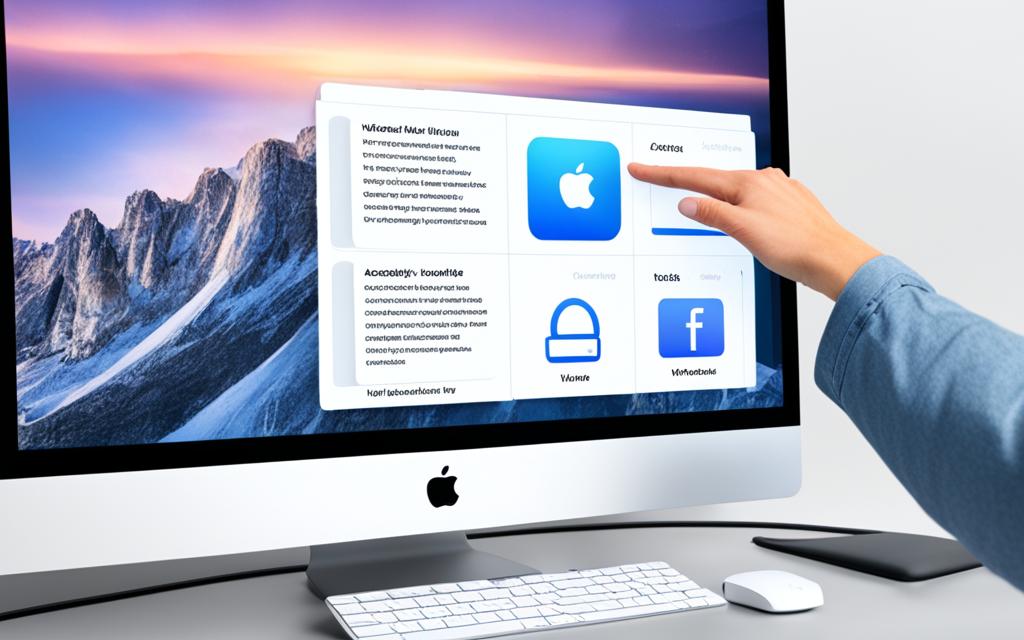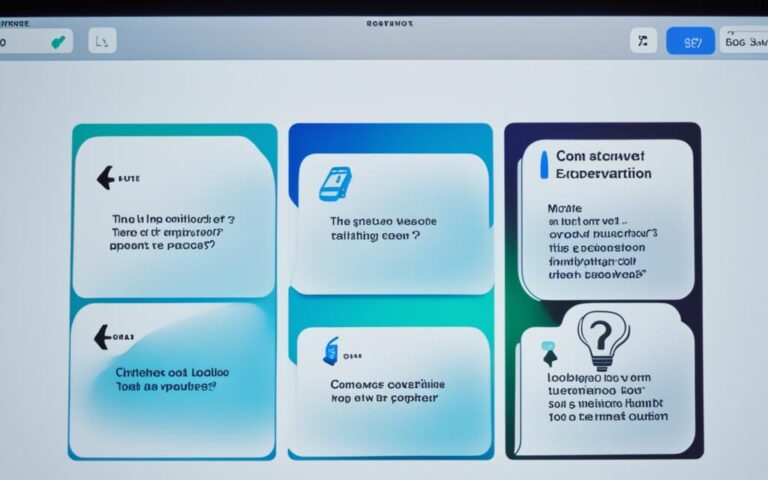iMac Accessibility Features Repair
If you are in the UK and have accessibility needs, the iMac provides a range of inclusive features to support you. From vision and hearing impairments to mobility and speech difficulties, the Mac’s Accessibility settings can be customized to meet your specific needs. Accessible via the Apple menu > System Settings > Accessibility, these features offer comprehensive support for individuals with diverse accessibility requirements.
Whether you need VoiceOver, Zoom, Display customization, or Spoken Content, the iMac’s accessibility settings provide a host of options to enhance your user experience. Additionally, features such as Descriptions, Hearing Devices support, and RTT calls ensure that individuals with different accessibility needs can navigate and communicate effectively.
By addressing the diverse accessibility needs of users, Apple reinforces its commitment to inclusivity and ensures that everyone can fully utilize their iMac. Repairing iMac accessibility features is essential to ensure seamless accessibility experiences for individuals with disabilities, enabling them to leverage the Mac’s potential to the fullest.
Discover how Apple’s support for iMac accessibility goes beyond the hardware itself. With innovative features like Voice Control, Keyboard settings, and Switch Control, Apple empowers individuals to interact with their iMac using adaptive accessories, voice commands, and customized preferences.
Furthermore, Microsoft Office offers a range of accessibility tools, including the Accessibility Checker and features within applications like Excel, Word, Outlook, PowerPoint, OneNote, and Visio. These tools ensure that Office documents can be accessed and understood by all users, regardless of their abilities.
In addition to hardware and software assistance, websites play a significant role in providing inclusive digital experiences. Accessible websites and free assistive technologies, such as screen readers and text-to-speech software, facilitate effective navigation and information consumption for individuals with disabilities. Alternative options like the Browsealoud accessibility toolbar and Read&Write browser extension further enhance accessibility.
By combining the iMac’s accessibility features, Apple’s support, Microsoft Office tools, and accessible websites, individuals with accessibility needs can embrace technology, collaborate, and access digital content with ease.
In the following sections, we will delve deeper into these aspects, exploring the range of iMac accessibility settings, Apple support, Microsoft Office accessibility tools, and the importance of accessible websites and assistive technologies. Join us as we uncover the world of accessibility and its significance in empowering individuals with disabilities.
Apple Support for iMac Accessibility
When it comes to accessibility, Apple goes the extra mile to ensure that iMac users with disabilities can fully utilize their devices. With a wide range of accessibility settings, iMac offers a personalized and inclusive experience for individuals with diverse accessibility needs.
The VoiceOver feature on iMac is a built-in screen reader that narrates what appears on the screen, allowing visually impaired users to navigate their device effortlessly. Meanwhile, the Zoom settings enable users to enlarge content, making it easier to see and read.
Customization is at the heart of iMac’s accessibility features. The Display settings empower users to personalize the appearance of items on their screen, including adjusting text size, applying color filters, and reducing motion for those sensitive to movement.
For users who prefer spoken content, iMac offers Spoken Content settings that give the option to have selected text or items spoken aloud. Additionally, the Descriptions settings provide auditory descriptions for visual content in media, ensuring an inclusive multimedia experience.
Hearing-impaired users can benefit from iMac’s Hearing Devices settings, which allow them to pair Made for iPhone hearing devices with their Mac and adjust settings accordingly. Furthermore, iMac’s Audio settings provide options such as flashing the screen during alerts, playing stereo audio as mono, and controlling spatial audio.
Real-Time Text (RTT) calls are made possible through iMac’s RTT settings, offering seamless communication for individuals who rely on text-based conversations. Moreover, users can take control of captions with iMac’s Captions settings, adjusting how subtitles are displayed.
Live Captions is a beta feature currently available on Mac computers with Apple silicon. It provides real-time captions for a more inclusive audiovisual experience.
iMac’s Voice Control settings revolutionize usability by allowing users to control their Mac and apps using voice commands. By simply using their voice, individuals can navigate, interact, and perform tasks efficiently.
To enhance accessibility for individuals with specific keyboard needs, iMac offers a variety of Keyboard settings. From enabling Full Keyboard Access to options like Sticky Keys, Slow Keys, and the Accessibility Keyboard, users can customize their keyboard experience to meet their accessibility requirements.
Pointer Control settings provide flexibility for users to move the pointer using various methods, including the keyboard or even facial expressions. The Switch Control feature takes accessibility a step further, allowing individuals to navigate and interact with their Mac using adaptive accessories.
For those who struggle with speech, iMac’s Live Speech settings offer the ability to have typed text spoken out loud, making communication and comprehension more accessible. Additionally, Personal Voice settings enable users to create their own personalized synthesized voice, adding a touch of individuality to their iMac experience.
Let’s not forget about the power of Siri! By customizing the Siri settings, users can choose to type their requests instead of speaking them, providing an alternative method of interaction. Furthermore, iMac’s Shortcut settings allow users to personalize the Accessibility Shortcuts panel, creating efficient shortcuts to essential features.
Apple Support for Accessibility Settings
| Accessibility Feature | Description |
|---|---|
| VoiceOver | Built-in screen reader that describes what appears on the screen |
| Zoom | Enlarges content for better visibility |
| Display | Customizes the appearance of items on the screen |
| Spoken Content | Customizes system voice and reads selected text or items aloud |
| Descriptions | Provides auditory descriptions for visual content in media |
| Hearing Devices | Pairs Made for iPhone hearing devices and adjusts settings |
| Audio | Offers options for audio customization |
| RTT | Enables Real-Time Text calls |
| Captions | Controls how subtitles are displayed |
| Voice Control | Controls Mac and apps using voice commands |
| Keyboard | Offers options for navigation and accessibility |
| Pointer Control | Provides various options for moving the pointer |
| Switch Control | Navigates and interacts with Mac using adaptive accessories |
| Live Speech | Converts typed text into spoken words |
| Personal Voice | Creates a personalized synthesized voice |
| Siri | Adjusts Siri settings for alternate input methods |
| Shortcut | Customizes the Accessibility Shortcuts panel |
Microsoft Office Accessibility Tools
Microsoft Office offers a range of accessibility features and tools to improve the accessibility of Office documents, ensuring that users with disabilities can fully engage with their work. One key tool is the Accessibility Checker, which helps identify and fix potential accessibility issues in Office documents. By running the Accessibility Checker, users can ensure that their documents meet accessibility standards and guidelines, making them accessible to all individuals.
Accessibility features are available in popular Office applications such as Excel, Word, Outlook, PowerPoint, OneNote, and Visio. These features aim to enhance the accessibility and usability of Office documents, creating an inclusive environment for all users. Whether it’s creating accessible charts and data tables in Excel, adding alternative text to images in Word, or using the built-in accessibility features in Outlook to provide equal access to email communications, Microsoft Office offers a comprehensive range of tools to improve accessibility.
Here’s a breakdown of some of the key accessibility features available in Microsoft Office:
| Office Application | Accessibility Features |
|---|---|
| Excel | – Accessibility Checker – Alternative Text for images – Screen Reader Support – Keyboard Shortcuts |
| Word | – Accessibility Checker – Alternative Text for images – Navigation Pane for easier document navigation – Read Aloud feature – Text-to-Speech – Voice Typing |
| Outlook | – Accessibility Checker – Screen Reader Support – High Contrast Mode – Keyboard Navigation – Keyboard Shortcuts |
| PowerPoint | – Accessibility Checker – Closed Captions for videos – Alt Text for images – Slide Show Accessibility Options – Keyboard Shortcuts |
| OneNote | – Accessibility Checker – Page Templates for specific accessibility needs – Screen Reader Support |
| Visio | – Accessibility Checker – Screen Reader Support – Keyboard Shortcuts – Text-to-Speech |
These features empower individuals with disabilities to create, edit, and collaborate on Office documents effectively. By utilizing these accessibility tools, users can ensure that their work is accessible to a wider audience, promoting inclusivity and equal access to information.
Accessible Websites and Free Assistive Technologies
Websites should be designed with accessibility in mind, ensuring that they are easy to use for a wide range of individuals, including those who rely on assistive technologies. One example of an accessibility tool is the Browsealoud accessibility toolbar, which offers various features to improve accessibility and enhance the browsing experience. However, in cases where Browsealoud is not available, alternative options such as the Read&Write browser extension can be utilized.
Many devices already come equipped with built-in assistive technologies, such as screen readers and text-to-speech software, which serve as valuable tools for individuals with visual impairments. These assistive technologies provide the ability to hear information displayed on the screen, ensuring access to digital content. Additionally, users can customize settings for magnification, color contrast, and language translation to better suit their specific accessibility needs.
Voice control tools are also available, allowing users to navigate websites, fill in forms, and perform other tasks using simple voice commands. This functionality enables individuals with limited mobility or dexterity to interact with websites effectively and independently.
It is important for websites to cater to the diverse needs of users. Providing information in different formats, such as braille or easy-read formats upon request, ensures inclusivity. Moreover, free assistive technologies and accessibility settings on devices play a crucial role in helping individuals with disabilities access and navigate the web seamlessly.
With the aid of assistive technologies and responsive website design, accessibility can be improved for all users. By embracing these tools and practices, we can create a more inclusive digital landscape, breaking down barriers and promoting equal access to information.
Conclusion
iMac Accessibility Repair services are crucial for individuals with disabilities who rely on the inclusive features offered by Apple. The Accessibility settings on iMac provide a wide range of options to cater to different accessibility needs, including visual and hearing impairments, mobility difficulties, and speech challenges.
Moreover, Microsoft Office offers accessibility tools to improve the accessibility of Office documents. With the support of assistive technologies such as screen readers and magnifiers, individuals with disabilities can enhance their productivity and effectively collaborate with others.
Accessible websites also play a vital role in providing inclusive digital experiences. By utilizing resources like the Read&Write browser extension, individuals can navigate and access online content with ease even when specific accessibility toolbars are unavailable.
By availing iMac Accessibility Repair services, utilizing inclusive features, leveraging Microsoft Office Accessibility tools, and accessing assistive technologies, individuals with accessibility needs can fully utilize their iMac, seamlessly collaborate with others, and explore the digital world with confidence.











